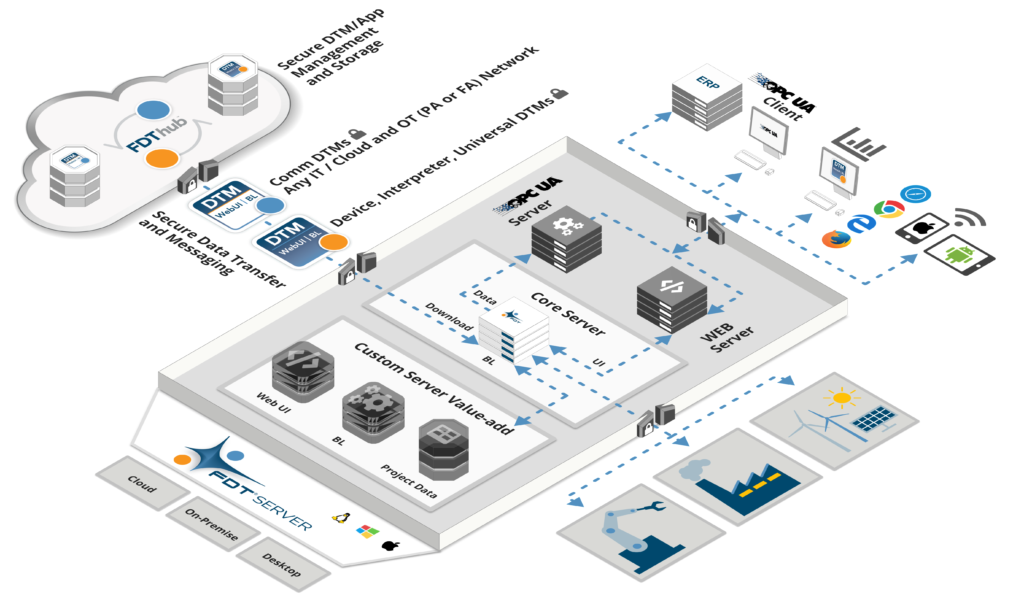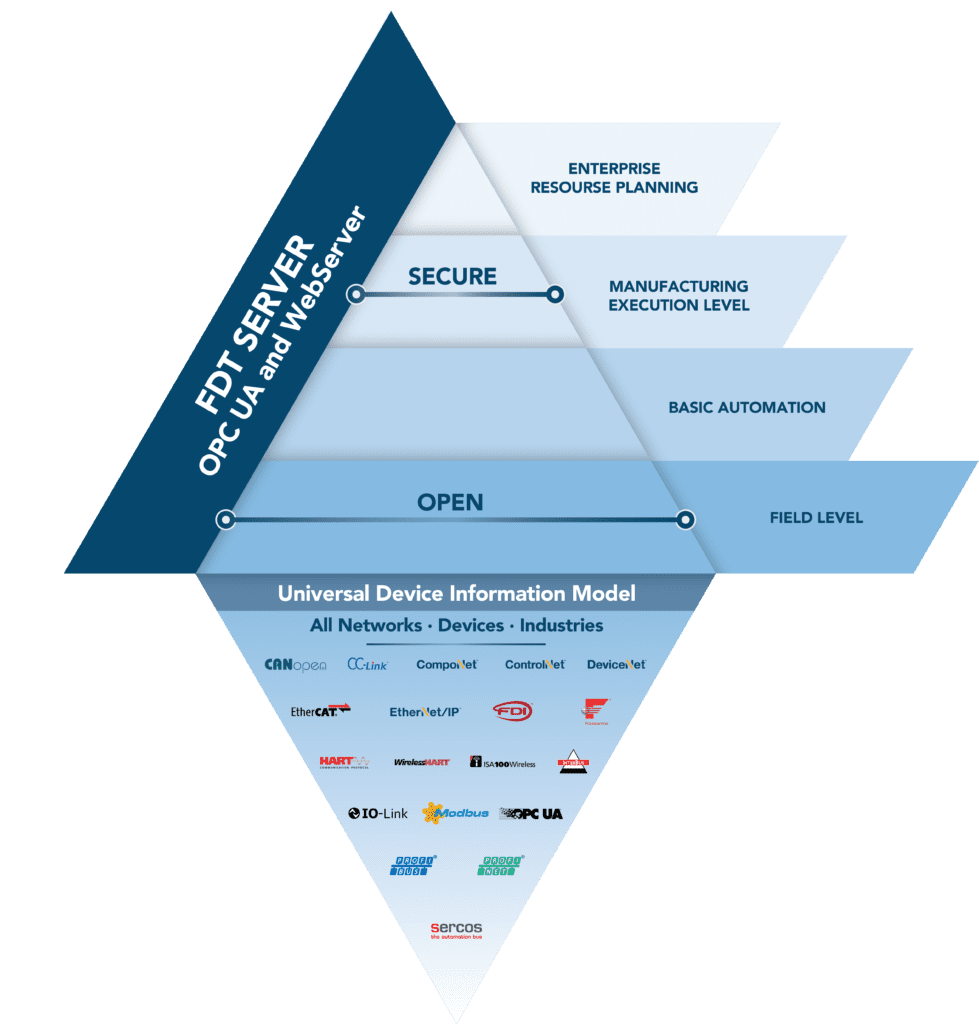
No matter what type of industrial process, hybrid or discrete automation application you are running, improving your maintenance and workflow practices will dramatically impact your bottom line, reduce unplanned and planned downtime, and improve operation and production performance.
Using advanced device diagnostics is the foundation of your digital journey and will accelerate a reliability-centered maintenance strategy based on a predictive and proactive approach.
For over 20 years, FDT technology has been enabling distributed control systems and smart field devices for all major vendors. The FDT technology standard, an IEC international (IEC 62453), an ISA (ANSI/ISA 103) and a Chinese (GB-T 29618-2017), enables point to point engineering environments and large open automation platforms to easily integrate and access intelligent device information streamlining lifecycle management independent of the field communication protocol or control system/device supplier.
Today, the FDT standard based on version FDT3 offers modern device management with IT/OT data-driven operations enabling smart maintenance practices. An easy way to add immediate value to your install base, is to ensure your system and intelligent devices are using the latest FDT3 standard. By doing so, you can tap into data that ensures these assets are operating at peak efficiency, enabling reliability centered maintenance strategies throughout the entire enterprise.
Companies that adopt the Industrial Internet of Things (IIoT) and novel technologies associated with predictive analytics and maintenance will be among the first to realize value.
FDT3 Optimizes Predictive Maintenance
It’s time to move from a culture of reactive to predictive and proactive maintenance, from ‘fix it when it breaks’ or scheduled maintenance activities to predictive maintenance based on diagnostics or alerts, with an optimized preventative schedule using historic and statistical data.
Using advanced analytics, operators gain insights from smart devices to predict equipment issues and optimize maintenance activities. The latest FDT3 Unified Environment (FDT UE) standard offers a data-centric FDT/DTM Server (OPC UA- and mobility-ready) platform for modern industrial device management enterprise-wide. Using new FDT3 Device Type Managers (DTMs) equipped with a WebUI and advanced business logic, operators are met with enhanced decision-making capabilities at their fingertips with access via thin clients – authenticated engineering application or mobile device with browser-access. Monitoring capabilities include collected diagnostics with standardized NE107 guidelines that define alert and notification symbols for fast and clear problem recognition and resolution. This makes the available information much more accessible to individuals without technical training and easier to use.
The FDTUE supports diverse deployment options, including cloud, edge, on-premise, and desktop environments for greenfield and brownfield plants and facilities.
Transitioning a maintenance strategy from fixing what’s broken to a strategy driven by the condition of the device enables the operation to avoid unnecessary shutdowns and circumvent added costs. With this transition, which will likely require a shift in the maintenance culture, users will appreciate the standard as it streamlines training and enables new maintenance workflows that save time and cost – the solution provides a single device management tool environment for connecting, maintaining, and monitoring any asset.
FDT UE allows the workforce to move from reactive to a predictive maintenance and proactive work culture, where users can analyze machine conditions to determine when equipment needs attention – enabling the shift from data availability to insight availability, and conversion of insights into actionability.
Unified Environment Empowers the Intelligent Enterprise
With FDT3, companies have the freedom to use data collaboratively to support new and existing manufacturing infrastructure through a smart, connected ecosystem of integrated machines and devices. Users can now bridge their legacy install base and scale their application to achieve modern industrial device management and IT/OT data access supporting smart manufacturing initiatives.
The FDT standard incorporates several specific DTM types (device and communication DTMs). These DTMs empower a standardized way of communicating, automatically making device data and health information available via the FDT Server. This architecture flattens the automation pyramid so that any application requiring data from devices can retrieve it directly from authenticated FDT, OPC UA or mobile clients.

Figure 1: FDT Server architecture supporting smart manufacturing and maintenance practices.
FDT empowers the intelligent enterprise by standardizing IT/OT integration and providing a secure gateway to network/device data and health information. With its utilization of an optional Publish-Subscribe environment, FDT allows for real-time data exchange. The FDT Web Server mobilizes field device operations allowing operators access to data anytime and anywhere. It optimizes monitoring and accessibility to actionable data, with real-time alerts, and diagnostics enabling new service-oriented business models for device management and maintenance initiatives.
DTMs can integrate any protocol, device/type/data model (common and device-specific parameters) and information model – a big advantage when talking about creating a unified environment that can support and sustain a reliability and maintenance-centered application across IT and OT teams in the enterprise.

Figure 2: The FDT Server solution encompasses a Universal Device Information Model for seamless integration and communication enhancing monitoring and optimization practices.
Investment in data-centric technologies and standards such as FDT improve maintenance practices and workflows for end users, impact production capabilities, and improve manufacturing efficiencies and sustainability by preventing unplanned shutdowns, reducing downtime, and lowering maintenance costs – all providing significant financial benefits.
Universal Lifecycle Management Tool
Designed for brownfield or greenfield applications, FDT optimizes the lifecycle cost of plants and factories while enhancing maintenance activities, increasing the safety of personnel and assets, and improving product quality. By being supplier and protocol agnostic, FDT is viewed as a universal lifecycle management tool allowing any device to connect and communicate in near-real-time, helping personnel make better and timelier decisions that affect the business.
FDT enables asset management by providing a single tool for device configuration, commissioning, monitoring, diagnostics, parameterization, and replacement. FDT provides a single way to integrate any device, creating one way to handle a device in different situations, including in the vendor tool, in the system environment, and in the service tool, and to consistently store the data of all devices.
For a system operator, service technicians can execute device service operations using a mobile device to access the device via the FDT Server. This way, all changes to the device can be tracked in a central audit trail.
With FDT working behind the scenes, operators can take advantage of a unified environment for industrial device management for all connected devices and processes and optimize monitoring capabilities with access to actionable data from a DCS, PLC, asset management application or mobile device via any major browser – key for modern control and asset management initiatives.
Use Cases Empower Next Generation Solutions
In its report, IEEE introduces the idea of implementing digital twin for predictive maintenance.
Introducing digital twin technology into a production system can improve predictive maintenance strategies – and the FDT Universal Environment enables multi-purpose digital twins. The strength of FDT has always been analytics – and now those analytics are even richer, with better device diagnostics and better performance.
In this use case, the MOL Group’s Danube Refinery in Százhalombatta, Hungary, wanted to improve their operation and overhaul its maintenance systems with a new, unified asset management system strategy. The refinery’s on-line systems use FDT technology embedded in their device configuration and maintenance systems; PRM from Yokogawa and FDM from Honeywell; enabling fast, simple and safe device configuration and diagnostics as an important part of their on-line maintenance system strategy. They used the information to identify the location of an asset problem, for device repair, and remotely accessing device information and changing the device configuration. Using the wealth of the available information, their goal was to improve maintenance processes, and human competencies and skills.
Lower Operating Costs, Improve Asset Management
A compelling gain of a predictive maintenance strategy is that many facilities can start taking advantage of FDT with little investment and very low risk. Most of the devices installed in facilities over the past 20 years are FDT DTM enabled – ready to contribute to lower operating cost and improved asset management.
Suppliers new to FDT or upgrading an existing product line will benefit from advancements that empower next generation FDT solutions. This includes an open, secure, fully standardized, and data-centric integration ecosystem connecting legacy investments with cloud, on-premise, edge, and enterprise access.
By being device, protocol, system and platform independent, FDT provides the unified environment to all connected intelligent measurement devices that have a direct influence on the profitability and availability of the operation. As in the case of MOL, plant performance can be significantly improved if users are willing to access and use the intelligent device information for more than just configuration.
Next Steps
Device intelligence is a game-changer and key to achieving a reliability centered maintenance strategy. Now is the time to take inventory of your equipment and ask for FDT device DTMs to reap the benefits of data driven operations supporting your application today and into the future. Vendors should ensure their system and devices are updated to the latest FDT3 version so users can scale their IIoT applications at their own pace.
Learn more about FDT3, modern industrial device management, and about selecting and specifying devices and applications that include FDT technology to access and use information from intelligent field devices to help prevent unplanned shutdowns, reduce downtime, and lower maintenance costs.